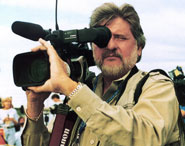 |
→ December 2005 Contents → Welcome
|
Welcome to the December issue of The Digital Journalist, the online monthly magazine for visual journalism.
The biggest continuing story for photojournalists in the world is Iraq. We have devoted several cover stories to it, and monthly photographers have contributed "Dispatches" from this desperate conflict. However, in the last year it has become increasingly difficult to get new photographs in a contextualized fashion from the war front. This is due to two problems, the first being that it is now exceedingly dangerous for western photographers to operate in and out of Baghdad. The other is that for some of the agency photographers working in the war zone, it has become necessary that they keep a low profile. Their very lives are in the balance.
That is why we were so impressed with a new book, "Unembedded," that has just been published by Chelsea Green. Photographers Ghaith Abdul-Ahad, Kael Alford, Thorne Anderson and Rita Leistner covered the battle for Najaf last August. It is a microcosm of the dilemma that Iraq poses. We highly commend their searing images to you.
As readers of this site know, we have devoted a lot of space in the past few months to Hurricane Katrina. Now, three months later, much of the Gulf Coast and the city of New Orleans still are inhabitable, and their residents in desperate need. It is a story that goes to the heart of how our society is functioning in the early 21st century. In October, photographer Ted Jackson of the New Orleans Times Picayune gave a presentation of his work covering Katrina, along with four other photographers, at the NPPA Flying Short Course at the University of Texas in Austin. Jackson's story of his own ordeal was so moving that we decided to travel to New Orleans and interview him. Our Beverly Spicer did the interview in a New Orleans hotel room after we had toured the devastated 9th Ward with him. We feel the story that emerged is compelling. Ted, speaking in his soft voice, tells of his personal journey through the floodwaters, and the difficulties the Times Picayune staff faced in publishing after their plant was flooded. We feel this is a story, in his pictures, and the five-part streaming video, that should be watched by everybody. It is an important story about how journalists overcome enormous odds to serve their community.
In "Dispatches," photographer Marco Di Lauro reports on what he saw in the bloody aftermath of a wedding party that was blown up by terrorist bombers in Amman, Jordan. Daniel Beltra, a photographer who specializes in environmental issues, gives us a look at the results of a severe drought in the Brazilian Amazon, and John Moore profiles women whose fathers, husbands and sons were killed by Saddam Hussein's forces in "The Widows of Dujail." In this month's "Update," storm chaser Jim Reed, who covered Hurricanes Katrina and Rita [see the Sept. 2005 DJ], has just published a book on his work during the storms. He tells us about what is was like covering the event in his update, "13 Hurricanes, a Book and a Broken Nose."
Executive Editor Peter Howe looks back over the troubling events of the past year, taking lessons out of the chaos of Iraq, the tsunami, and the hurricanes to remind us how important photojournalism is in helping us to make sense of events that seem to be beyond our control.
Our Ron Steinman looks wistfully at a debate, which we all would really like to see between political candidates, but this one happened on the tube during "The West Wing."
Also, Ron reviewed Paul Fusco's latest photo project last month in our sister publication, The Digital Filmmaker, and we share it with you here. Entitled "Bitter Fruit," Fusco's portfolio documents the funerals of American soldiers who died in Iraq, and the human toll the war continues to take on their surviving loved ones. It is a poignant piece from Magnum's Fusco, known for his coverage of social issues.
Jim Colburn recently spent a day assisting David Burnett on assignment, something he never had a chance to do as a Time picture editor, and he writes about what it was like watching a master at work.
Chuck Westfall is back to answer your questions in his helpful monthly "Tech Tips" column. Also, as usual, it's worth a trip to Mark Loundy's and Terry Heaton's columns for their latest insight.
With high comedy from a real politician looking for a way out, and help from Triumph the Insult Comic Dog and political cartoonist Oliphant, "E-Bits" Editor Beverly Spicer takes on the concepts of no escape, lightning wars and political absurdity while searching for equanimity through laughter.
"Assignment Sheet" is pleased to bring you some interesting reading about reality and life in photojournalism as seen from the prospective of two veterans; one in television and one in the print media. In "Brinkley and Me," former NBC producer Ron Steinman writes about his first months in television journalism and how that time was crucial to him in forging his career. Dick Kraus also looks back on his career and remembers the frustrations and obstacles of covering political conventions, and also recalls a Damon Runyonesque former city editor with whom he covered a U.S. Customs agent working on the original Queen Mary ship, in a story entitled "Jack and the Queen."
Finally, we end with a sad note. Our good friend Michael Evans died at home in Atlanta, Ga., last week after a heroic four-year battle against cancer. Michael was President Reagan's personal photographer, a prolific photojournalist, and an innovator in digital photographic storage systems. Next month we will devote a special part of the magazine to his work and life. In the meantime, please read the fine obituary written by Peter Junker at http://nppa.org/news_and_events/news/2005/12/evans.html.
We hope you enjoy this issue and wish you a happy holiday season. Dirck Halstead
| ||||||
